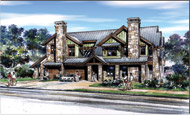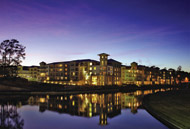| COVER STORY, JULY 2009
ON TOPIC: ARCHITECTURE TRENDS
Humphreys & Partners continues to create innovative products.
Interview by Coleman Wood
With new construction in many Texas markets slowing down or even halting in some cases, everyone in the building sector is feeling the pinch. This month, Texas Real Estate Business spoke with Mark Humphreys, CEO of Dallas-based architecture firm Humphreys & Partners to see what new ideas his firm is coming up with to stay active during the current recession.
TREB: Tell us about Humphreys & Partners’ new landscape architecture division. Why was it launched and what do you hope to accomplish with it?
Humphreys: We were approached by a landscape architecture group out of Phoenix a couple of times about buying the company. I wasn’t as interested at first, because we were watching cash flow and buying companies was not on the front burner. Finally, the owner mentioned that we were his only client ath that time and said that he thought it made a lot of sense for him to become part of my company. By doing that, he could make us money, we would have a landscape company, and he would probably get more work because we would give him more of our projects. Since then, he’s doubled his business, we’re making the money off a landscape company that we acquired for not much, and everybody is a winner.
Our strategic plan was always to be more diversified. Our interior design group already does really well. It’s one of the highest billing in Dallas. We wanted to further diversify by adding civil engineering and landscape. We were also interested in construction management. All of those things have been on our target — to acquire if the right fit came. So it worked out great.
TREB: Do you see the green movement as the latest design fad, or do you think that it is here to stay?
 |
Preserve on Fredicksburg in San Antonio
|
|
Humphreys: Environmental design is not a new design fad. It’s just been in hibernation. What we are seeing is that not only is it not a fad, but if you talk to the Y Generation about the importance of issues in their lives and how important the green movement is, if it’s not number 1, then it’s very close to number 1 on their priority lists. I have three daughters that are all college-age and they ask me quite frequently what I am doing, as an architect, for the environment.
We did a project in Houston called Newport on the Lake, which is our Big House® copyrighted design. We did some very environmentally friendly landscaping — using native plants and trees — and it really was a fun thing to do. Once the landscape got established, we didn’t need to water it. So, not only does it become the right thing to do and the environmental thing to do, but the economics are such that if you do not have to water your landscape, then you’re saving on your water bill. The fact that we cut down on our water usage saved us somewhere around $50,000 in operating costs every year.
TREB: Humphreys & Partners is one of the few architecture firms in Texas to release branded concepts, including the Big House, e-MaxSM and e-Urban®. What led to these ideas and how successful are these brands?
Humphreys: I like to use an aviation analogy. We don’t want to be the one person building experimental airplanes one at a time in his garage. We want to be like Boeing’s computerized assembly line. The point is that if we can come up with designs and concepts where there is a demand, then we can sell it over and over again, and improve it instead of building a new one every single time.
The Big House, which was our first branded design was developed back in 1994. We get as many calls today or more than we did when it first started. Since 1994, we have done over 200 Big House projects. At $25 million apiece, that’s $5 billion worth of work for one product type.
 |
A prototype rendering of the e-Urban design.
|
|
We showed our e-Urban concept, which we came up with about a year-and-a-half ago, to Ron Terwilliger, head of Trammell Crow Residential. Ron looked at me and said, ‘You figured it out. You figured out the answer.” And that send chills down my back to hear the head of Trammell Crow Residential say that we had figured out something that the industry needed and no one had. The e-Urban is a half to two-thirds of what we are selling right now. We brand everything so that it is a recognizable name
The e-Max is meant to meet the demand of Echo Boomers, who want to live in the new, hot inner city areas, but, since they are just getting out of college, they’re not making the top salaries. The answer to that is smaller units. Manhattan has realized that. Japan has realized that, as has China and Toronto. It’s our time. We can now get to 70 units per acre with this design because it’s smaller. This lowers your land cost and your effective rent is almost half. I think it’s safe to say that it maximizes your profit and density for the maximum demand that is coming out the doors of our universities right now.
TREB: In today’s economy, with new construction slowing considerably , how important is it for an architecture firm to keep coming up with new ideas and branching out?
 |
a Section 8 project completed for the Dallas Housing Authority
|
|
Humphreys: It is extremely important. We market all the time, whereas 90 percent of architecture firms don’t market unless they don’t have any work. We’re emailing 20,000 people that are developers, finance people, and others in the business. Strategically, it is of the utmost importance because we try to soften these downward cycles or skip over them entirely.
TREB: What else is your firm doing to stay active?
Humphreys: We’re focused on student housing. It’s very strong nationally and internationally, and we have a concept for that, too, called the e-Urban Student ®. It is the hottest thing going out there and I’m not making a false statement. A standard student housing project doesn’t even come close to it. Our deal blows everything away.
 |
Boardwalk at Town Center in The Woodlands, Texas
|
|
TREB: Are there any architecture trends right now that you see becoming more popular in the future?
Humphreys: Workforce housing. Urbanization of the U.S. is going to continue in a big way. We got a very big taste of it through this last cycle and that’s not going to end. I heard a report the other day that 10 years ago, an acceptable commute time was 45 minutes. I heard today it’s 10 minutes, so that tells you something right there. We’re going to be urbanizing where the work is and that’s a good thing. That’s where I see the future.
©2009 France Publications, Inc. Duplication
or reproduction of this article not permitted without authorization
from France Publications, Inc. For information on reprints of
this article contact Barbara
Sherer at (630) 554-6054.
|
